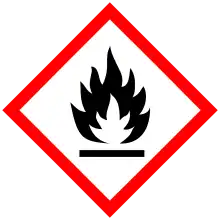| Names | |
|---|---|
| IUPAC name
Titanium disilicide | |
| Other names
Titanium silicide | |
| Identifiers | |
3D model (JSmol) |
|
| ECHA InfoCard | 100.031.719 |
| EC Number |
|
PubChem CID |
|
CompTox Dashboard (EPA) |
|
| |
| |
| Properties | |
| TiSi2 | |
| Molar mass | 104.038 g/mol |
| Appearance | black orthorhombic crystals |
| Density | 4.02 g/cm3 |
| Melting point | 1,470 °C (2,680 °F; 1,740 K) |
| insoluble | |
| Solubility | soluble in HF |
| Hazards | |
| GHS labelling: | |
  | |
| Warning | |
| H228, H315, H319, H335 | |
| P210, P240, P241, P261, P264, P271, P280, P302+P352, P304+P340, P305+P351+P338, P312, P321, P332+P313, P337+P313, P362, P370+P378, P403+P233, P405, P501 | |
| Safety data sheet (SDS) | |
| Related compounds | |
Other cations |
Zirconium disilicide Hafnium disilicide |
Except where otherwise noted, data are given for materials in their standard state (at 25 °C [77 °F], 100 kPa).
Infobox references | |
Titanium disilicide (TiSi2) is an inorganic chemical compound of titanium and silicon.
Preparation
Titanium disilicide can be obtained from the reaction between titanium or titanium hydride with silicon.[2]
- Ti + 2 Si → TiSi2
It is also possible to prepare it aluminothermically by the ignition of aluminium powder, sulfur, silicon dioxide, and titanium dioxide or potassium hexafluorotitanate, K2TiF6, by electrolysis of a melt of potassium hexafluorotitanate and titanium dioxide, or by reaction of titanium with silicon tetrachloride.[2]
Another method is the reaction of titanium tetrachloride with silane, dichlorosilane or silicon.[3]
- TiCl4 + 2 SiH4 → TiSi2 + 4 HCl + 2 H2
- TiCl4 + 2 SiH2Cl2 + 2 H2 → TiSi2 + 8 HCl
- TiCl4 + 3 Si → TiSi2 + SiCl4
Uses
Titanium silicide is used in the semiconductor industry. It is typically grown by means of salicide technology over silicon and polysilicon lines to reduce the sheet resistance of local transistors connections. In the microelectronic industry it is typically used in the C54 phase.
References
- ↑ Lide, David R. (1998), Handbook of Chemistry and Physics (87 ed.), Boca Raton, Florida: CRC Press, pp. 4–91, ISBN 0-8493-0594-2
- 1 2 Brauer, Georg (1978). Handbuch der Präparativen Anorganischen Chemie, Band II. Baudler, Marianne (3rd ed.). Stuttgart: Enke. p. 1389. ISBN 978-3-432-87813-3. OCLC 310719490.
- ↑ Pierson, Hugh O. (1999). Handbook of Chemical Vapor Deposition : Principles, Technology, and Applications (2nd ed.). Norwich, N.Y.: Noyes Publications. p. 331. ISBN 1-59124-030-1. OCLC 49708617.